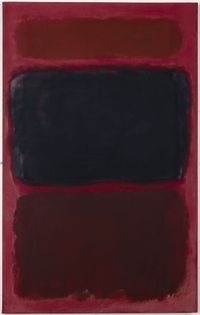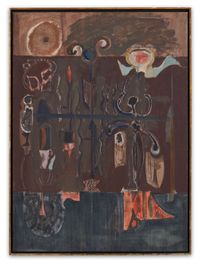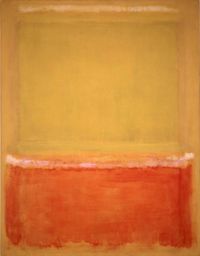'The people who weep before my pictures are having the same religious experience I had when I painted them', colour field painter Mark Rothko once remarked. The continued power of these large-scale canvases stained in swathes of vivid colour sustain Rothko's legacy as one of the most significant American postwar artists.
Read MoreBorn Marcus Rothkowitz in Dvinsk, Russia (today Daugavpils, Latvia) in 1903, the artist and his family settled in Portland, Oregon, in 1913. He entered Yale University in 1921 but dropped out in 1923 and moved to New York, where he studied at the Art Students League under Jewish-American artist Max Weber. In New York, Rothko became close with a number of influential 20th-century artists, including the painters Milton Avery and Adolph Gottlieb.
Mark Rothko began the colour field artworks for which he is known in the late 1940s. A subset of Abstract Expressionism, colour field painting refers to a group of abstract painters in the postwar period known for using large areas of flat colour. The term originally referred to Rothko, Clyfford Still, and Barnett Newman, and later extended to artists including Morris Louis, Helen Frankenthaler, and Kenneth Noland.
In Rothko's work, the colour field painting genre manifests in large vertical canvases covered in layers of thinned paint that produce stacked rectangles of colour. Though his paintings have often been described as soothing or contemplative, the artist disagreed, calling himself 'the most violent of all the American painters. Behind those colors there hides the final cataclysm.'
Though Mark Rothko rejects his identification with the Abstract Expressionists, his view of his paintings as harbouring a sense of destruction aligns with the ethos underpinning the movement, which emerged from a collective horror at the atrocities of World War II and humanity's capacity for destruction.
Throughout his life, Rothko emphasised his desire for his artwork to be viewed with full attention, admiring Michelangelo's Laurentian Library in Florence for making 'the viewers feel that they are trapped in a room where all the doors and windows are bricked up, so that all they can do is butt their heads forever against the wall.'
In the late 1950s, Mark Rothko was commissioned to produce a series of canvases for New York's Four Seasons Restaurant. However, dissatisfied with the distracting nature of the restaurant setting, he presented the paintings to the Tate as a gift in the late 1960s. They were exhibited in an intimate room at the Tate Modern between 2016 and 2020. In service of similarly focused viewing, in 2020 Stedelijk Museum Schiedam presented Grey, Orange on Maroon, No. 8 (1960) in a subtly lit room into which only one viewer was permitted at a time.
Rothko died by taking his own life in 1970. His work is part of most major collections throughout the world, including The Metropolitan Museum of Art, New York; National Gallery of Victoria, Melbourne; and The National Museum of Art, Osaka. The 14 dark, looming murals that comprise the Rothko Chapel (the Institute of Religion and Human Development's chapel) remain permanently on display in Houston.
Biography by Ocula | 2020






